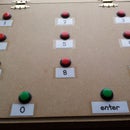Introduction: Frankenstein Light Switch
I saw one of these Frankenstein throw switches online but I could only see ones available in the U.S. - and these didn't seem suitable for the Gang 1 light switches that I have in my house. Then I thought I could easily design and make one to fit, and for little material cost.
What's good about this is that it just fits over the light switch, so no tampering with the electrics.
Disclaimer: I'm no electrician and am not sure about regulations regarding household fittings - I've done this just for fun based on what I've seen commercially available, and to see if I could. As far as I can see it's just a cover over a cover - the mechanism just replicates what your finger does when you turn on a switch. If you attempt this you do so at your own risk.
Here's what I used.
- 12mm MDF
- 10mm Diameter dowel
- Old chisel handle
- Photo frame pendants (for the on/off)
- Black spray paint
- Silver Rub 'n Buff
Additionally, access to a computer with printer and laminator.
Step 1:
I cut a piece of MDF to dimensions 19.5cm x 12cm, this will form the base plate. Additionally, as I had access to a circular saw, I cut a long strip with a width of 2cm - this would later form the switch mechanism.
I then marked a section in the middle of the base plate (area: 9cm x 9cm approx.) for the light switch to fit through. Using a spade-type drill bit (or a forstner bit) I drilled through roughly 3/4 of the 12mm MDF thickness (making sure not to go all the way through). This is just to take some of the hard work out of the chiselling. Then I proceeded to chisel what remained checking against the light switch regularly so as not to overdo it.
Step 2:
From the strip of MDF I had cut in Step 1, I cut this further into 10.5cm (x2 for the arms of the switch); 7cm (x1 for the head); and 2 semi-circles with a base measuring 4cm. I cut this slowly with a hacksaw (a coping saw would have been better but I didn't have one to hand).
I measured the centre-point on the base plate and cut out the slot for the actual light switch to fit through. I also used the centre-point to mark where to glue the semi-circles. I fixed everything together roughly to test it all lined up. Again, measuring centre-points in the semi-circles and in the ends of the arms to mark where to drill in preparation for the dowel piece.
Step 3:
I cut a 10mm diameter hole through all the necessary pieces then gently tapped in the dowel and sanded as required for a smoother action. I then offered the whole lot to the light switch and, using a piece of Blu-Tack, molded how the rocker mechanism would need to be cut. I then proceeded to cut this out from a piece of wood then fixed it in place in the centre of the dowel.
Step 4:
I sourced these photo pendants from ebay because I thought they would make excellent vintage-looking on/off labels. I made up some on/off graphics using Illustrator and printed them on photo paper then laminated and stuck them in to the pendants. I then marked on the switch where they should be fixed, then chiselled it out so they would fit flush.
Then I spray painted the whole thing matt black, sanded, sprayed again, then sanded again. Then, using silver Rub 'n Buff, I scarcely applied a thin layer over the entire surface, using wire-wool to add a brushed steel-type effect.
Step 5:
Admire....






